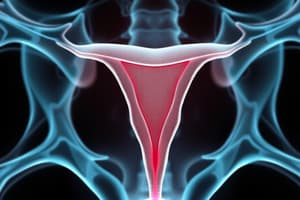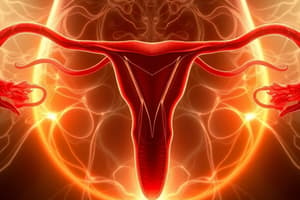Podcast
Questions and Answers
Apa yang terjadi setelah zigot terbentuk?
Apa yang terjadi setelah zigot terbentuk?
- Zigot berubah menjadi spermatozoa.
- Zigot langsung menjadi janin.
- Zigot diimplan di dinding rahim. (correct)
- Zigot menghilang.
Tahapan mana yang termasuk dalam proses persalinan?
Tahapan mana yang termasuk dalam proses persalinan?
- Ekspulsi (correct)
- Implantasi
- Denyut jantung
- Ovulasi
Apa fungsi utama dari ovarium dalam sistem reproduksi wanita?
Apa fungsi utama dari ovarium dalam sistem reproduksi wanita?
- Menjadi tempat perkembangan janin
- Menyalurkan sperma ke saluran telur
- Menyimpan dan mematangkan sperma
- Memproduksi sel telur dan hormon wanita (correct)
Apa fungsi utama hormon estrogen dalam siklus reproduksi wanita?
Apa fungsi utama hormon estrogen dalam siklus reproduksi wanita?
Di mana proses fertilisasi biasanya terjadi?
Di mana proses fertilisasi biasanya terjadi?
Apa fase yang ditandai dengan keluarnya darah dari tubuh wanita?
Apa fase yang ditandai dengan keluarnya darah dari tubuh wanita?
Apa peran utama dari kelenjar prostat dalam sistem reproduksi pria?
Apa peran utama dari kelenjar prostat dalam sistem reproduksi pria?
Apa yang dimaksud dengan infertilitas?
Apa yang dimaksud dengan infertilitas?
Apa itu spermatogenesis?
Apa itu spermatogenesis?
Apa fungsi dari skrotum dalam sistem reproduksi pria?
Apa fungsi dari skrotum dalam sistem reproduksi pria?
Flashcards
Sistem Reproduksi Manusia
Sistem Reproduksi Manusia
Sistem biologis kompleks yang bertanggung jawab atas pembuatan kehidupan baru pada manusia, melibatkan interaksi berbagai organ dan struktur pada pria dan wanita.
Testis
Testis
Organ reproduksi utama pria yang menghasilkan sperma dan testosteron.
Ovarium
Ovarium
Organ reproduksi utama wanita yang menghasilkan ovum (telur) dan hormon wanita seperti estrogen dan progesteron.
Pembuahan
Pembuahan
Signup and view all the flashcards
Spermatogenesis
Spermatogenesis
Signup and view all the flashcards
Zygote
Zygote
Signup and view all the flashcards
Implantasi
Implantasi
Signup and view all the flashcards
Fetal Development
Fetal Development
Signup and view all the flashcards
Hormonal Regulation
Hormonal Regulation
Signup and view all the flashcards
Menstruasi
Menstruasi
Signup and view all the flashcards
Study Notes
Sistem Reproduksi Manusia: Overview
- The human reproductive system is a complex biological system responsible for the creation of new life. It involves the interaction of several organs and structures in both males and females.
- Key functions include gamete production, fertilization, prenatal development of the embryo, and childbirth.
Male Reproductive System
- Testes: These are the primary male reproductive organs. They produce sperm and testosterone.
- Epididymis: A coiled tube that stores and matures sperm.
- Vas Deferens: A tube that carries sperm from the epididymis to the ejaculatory duct.
- Seminal Vesicles: Produce seminal fluid, a component of semen that nourishes and protects sperm.
- Prostate Gland: Secretes a fluid that contributes to semen, aiding in sperm motility and viability.
- Bulbourethral Glands (Cowper's glands): Secrete a clear mucus-like fluid that lubricates the urethra, and neutralizes any acidity present in the urethra.
- Penis: The external organ that facilitates the delivery of sperm through the urethra.
- Scrotum: A sac of skin that holds the testes, helping regulate their temperature.
Female Reproductive System
- Ovaries: The primary female reproductive organs that produce eggs (ova) and female hormones like estrogen and progesterone.
- Fallopian Tubes (Oviducts): These tubes connect the ovaries to the uterus. Fertilization typically occurs in the fallopian tubes.
- Uterus (Womb): A muscular organ where the fertilized egg implants and develops into a fetus during pregnancy.
- Cervix: The lower part of the uterus that opens into the vagina. It acts as a protective barrier during pregnancy and helps regulate the passage of sperm and the menstrual flow.
- Vagina: The birth canal, also a pathway for menstrual flow and sexual intercourse.
- Vulva: The external female genitalia, encompassing the labia, clitoris, and surrounding tissues.
Gametogenesis
- Spermatogenesis: The process of sperm production in the testes, involving meiosis.
- Oogenesis: The process of egg (ovum) production in the ovaries, also involving meiosis, but with significant differences in timing and outcome compared to spermatogenesis. One mature egg is produced for each cycle, while many sperm are created.
Fertilization
- Fertilization occurs when a sperm unites with an egg.
- The process of fertilization typically happens in the fallopian tubes.
- The union forms a zygote, which begins the development of a new organism.
Pregnancy and Development
- Implantation: After fertilization, the zygote implants in the uterine lining.
- Embryonic Development: Early stages of development, where the embryo forms essential structures such as the nervous system and major organs.
- Fetal Development: The subsequent period of development where organs mature and the fetus grows.
- Gestation: The entire period of pregnancy, typically lasting nine months (approximately 40 weeks) in humans.
Childbirth
- This is a complex process involving contractions of the uterine muscles, dilation of the cervix, and expulsion of the fetus.
- Different stages of labor: Dilation, expulsion, and placental.
Hormonal Regulation
- Hormones play a critical role in regulating the reproductive cycle in both males and females.
- Key hormones include follicle-stimulating hormone (FSH), luteinizing hormone (LH), estrogen, progesterone, and testosterone.
- These hormones control various aspects of gamete production, maturation, ovulation, and maintaining the uterine environment.
Menstrual Cycle (Female)
- A monthly cycle of changes in the uterus preparing it for a potential pregnancy.
- Characterized by phases like menstruation, follicular phase, ovulation, and luteal phase.
Reproductive Health and Issues
- Infertility: Inability to conceive a child.
- STIs (Sexually Transmitted Infections): Various infections that can be transmitted through sexual contact.
- Contraception: Methods to prevent pregnancy.
- Menopause: Cessation of menstruation and reproductive capacity in females.
Studying That Suits You
Use AI to generate personalized quizzes and flashcards to suit your learning preferences.




